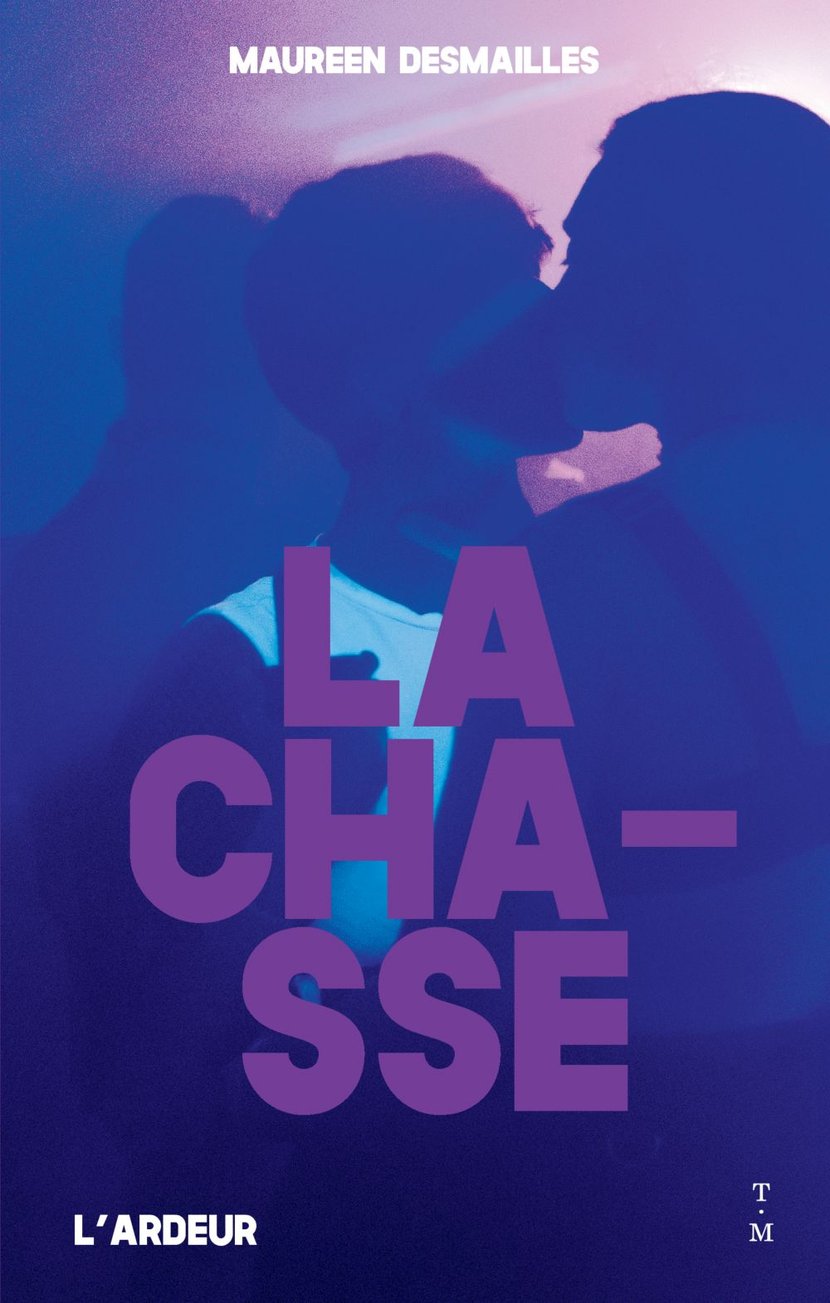What is the Hunt about?
Since childhood, seventeen-year-old Max has felt invisible. Always at odds, often in the shadow of his brilliant brother.
But that summer, Ellie and her boyfriend, Cosme, came to vacation at the house across the street. They both love each other in a sunny, blinding way. Free. And one thing is certain: in their eyes Max is anything but invisible.
When the narrator has no gender, our formatted imagination gives him one
In this novel, the sex of the main character, Max, is undetermined. Don’t make it a mystery to solve. {…} Also, address your preconceptions: At what moments do you read the character as masculine or feminine, and why? What prejudices drive you there? Does the story change with the gender of the narrator?
In matters of sexuality, as in all areas, no gesture, no practice, no emotion is the prerogative of one gender or another: everyone can be afraid, everyone can penetrate – and the whole world needs a condom.
Preface to The Huntthe novel by Maureen Desmailles.
What happens when you read a story of loves, of desires, of wounded pride AND sex ignoring the gender of the narrator ? Maureen Desmailles makes us live this experience beyond theory, placing it at the center the solitude and intimacy of readingwhere the evidence of our instincts, our sensations and our beliefs is more incisive.
Maureen Desmailles never mentions the character’s gender, in the story or in the writing. In particular, she eliminates any presence of the final “e”, the traditional feminine sign. “Exposing” this genre is not the aim of the book at all. However, we continue to think during the scenes: “Maximum he is enterprising·And, must be a male. ». Then, a few pages later, “Max makes love paying attention to the pleasure of his partner – in fact, maybe it’s a girl” ; “To think like that, he’s a boy; To behave like this he is a girl”, etc..
But in reality what matters is the possibility of identified to a character who is a girl, a boy, a bit of both, neither, it doesn’t matter. What matters is to confront what we consider feminine, or masculine… to ultimately better understand how superficial gender can be.
Reading, love and desire liberated from gender
We don’t just follow what the author chose for these characters, identify with them, or judge them. We are impressed by how much binary female/male norms determine our view of the world. The author takes us beyond gender barriers, In a rarely explored territory of literature and imagination. We find ourselves reading this masterful first novel in one go despite its 240 pages.
There is a meeting with oneself exultant in this freedom what Desmailles tells us. Create a writing device if meticulous that allows him to do so replace her omnipresence as an author with our instinct, our subjectivity. We leave this reading having identified ourselves·and has words that tell the story perfectly Ache of crushed self-confidence, the moist heat of desire, the will to live following a meeting.
We close the book also having a visceral awareness the fragility of gender norms : If Maureen Desmailles could write a novel without having it it is never necessary to choose between masculine and feminine, it is true that gender, ultimately, is nothing but a pure construction. In the secret of reading, we realize how much the genre is fragileovertaken, to better reach meetings, love and sex free from all limits.

Meeting with Maureen Desmailles, author of La Chasse
To miss. How was La Chasse born?
Maureen Desmailles. It all started with a book I discovered two years ago, Queen Kong, by Hélène Vignal. The book was published by L’Ardeur, a collection of erotic novels for teenagers and young adults. To this day, I think it’s the best book that I’ve been reading for the last five or six years. At the same time, as a thirty-year-old reader, he appealed to me enormously. But it also resonated thematically and politically with things that were important to me, and in particular with my conception of what children’s literature can be.
That’s when I wanted to write for L’Ardeur. What convinced the publishers to publish my manuscript was this concept of a book told in the first person with a love triangle and a narrator whose gender we don’t know.
I myself don’t know if Max is a girl or a boy.
Maureen Desmailles
What happens as an author when you write the story of a character whose gender you don’t know?
What’s interesting is this when you remove the gender parameter, the character continues to exist completely. We always have the impression that gender determines character. Furthermore, this is always what we give first, for example, when we propose a story. Let’s start by saying “the character is a man of this age, a woman of this age…”. You can actually build a story with other parameters that matter just as much.
And at the same time, if you take away the genre, this oscillation is interesting because it reveals a set of different stories. Opens several options for reading the book. You can read it and decide that you don’t decide, that you’re not interested, or you can decide that the character is a girl, a boy… what interests me is to see at which moments, in your opinion, the story changes, where, for you, the events do not have the same resonance. You can also read the novel in looking for when the character is a girl or a boy. I don’t know myself. For me the book is not a treasure hunt to try to guess the narrator’s gender. What interests me is that it is really the reader’s responsibility to decide whether or not to choose and to decide what to choose.
Did you have any difficulty writing a character whose gender is neutral? For example, have you come across any words or phrases that you couldn’t “degender”?
These difficulties arose initially because it took time my stylistic constraint meets the story itself. During this trial and error, I was still very much influenced by the gender constraints of the French language. The first formulas that came to me were very gender-related. So we had to work to find deviations. But finally, I was quick to get rid of this difficulty as soon as I understood the character.
Max was really born without this data. It’s a bit like I wrote without knowing his hair color: this parameter doesn’t matter! Gender really became just another feature I could ignore. From that moment on I no longer encountered any difficulties.
Let’s talk about the sex scenes. There are several of them in the novel. Did you write the book with the desire to create erotic literature?
It wasn’t particularly what I wanted at first, but the staging and writing of sexuality has always interested me, politically and thematically. I find it complicated and so on crystallizes many issues of power, feminism, stereotypes, discrimination, gender identity.
The question she asked herself was that I absolutely wanted to avoid simply writing a book about sex. What struck me a lot in Queen Kongis that the way he portrayed his character’s sexuality was not masturbatory in nature. Queen Kongis the story of a teenager who wrests her sexual independence from the judgments, standards and condescension of others. Sexuality is history. The novel is very short and recounts four times in which she sleeps with a different boy. There’s only that, though, the four scenes tell something different and decisive. Every time is a lesson something she learns about herself, about society…Reading this book, I told myself that if I were going to write about sex, I would do it like this.
[Les réflexions de Maureen Desmailles sur la littérature et notamment sur la question des scènes de sexe sont à découvrir sur son blog, Furax. Et on vous prévient : c’est passionnant.]
This means that at the beginning of your project you did not come away tired, frustrated or even annoyed by the majority of sex scenes present in literature, films and television series, which reproduce an unrealistic, stereotyped or even oppressive vision.
Self ! When it came to writing, these questions arose. Yes, responding to the bad sex scenes that saturate adolescent literature is precisely the concept of the collection L’Ardeur, which seeks to offer other types of representations of adolescent sexuality. And then, when I started writing, I asked myself the question of the scenes that I found good and those that I found bad in the books, asking myself why.
I even remember a sex scene in a novel that was real torture. She pissed me off so much that I talked to my therapist about it! As I wrote, I often returned to this scene wondering “because it does not work?” ». This question is a work in progress that cannot be exhausted because it involves questioning one’s relationship with sexuality and its relationship with writing.
The Hunt, Maureen Desmailles, Éditions Thierry Magnier, L’Ardeur Collection, 240 pages, €15.90.
Listen to Apéro des Daronnes, Madmoizelle’s show that aims to break down taboos on parenting.
Source: Madmoizelle
Mary Crossley is an author at “The Fashion Vibes”. She is a seasoned journalist who is dedicated to delivering the latest news to her readers. With a keen sense of what’s important, Mary covers a wide range of topics, from politics to lifestyle and everything in between.




